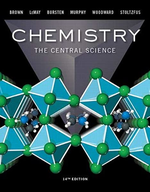?Ethylene glycol \(\left(\mathrm{HOCH}_{2} \mathrm{CH}_{2} \mathrm{OH}\right)\), the
Chapter 11, Problem 11.27(choose chapter or problem)
Ethylene glycol \(\left(\mathrm{HOCH}_{2} \mathrm{CH}_{2} \mathrm{OH}\right)\), the major substance in antifreeze, has a normal boiling point of \(198^{\circ} \mathrm{C}\). By comparison, ethyl alcohol \(\left(\mathrm{CH}_{3} \mathrm{CH}_{2} \mathrm{OH}\right)\) boils at \(78^{\circ} \mathrm{C}\) at atmospheric pressure. Ethylene glycol dimethyl ether \(\left(\mathrm{CH}_{3} \mathrm{OCH}_{2} \mathrm{CH}_{2} \mathrm{OCH}_{3}\right)\) has a normal boiling point of \(83^{\circ} \mathrm{C}\), and ethyl methyl ether \(\left(\mathrm{CH}_{3} \mathrm{CH}_{2} \mathrm{OCH}_{3}\right)\) has a normal boiling point of \(11^{\circ} \mathrm{C}\).
(a) Explain why replacement of a hydrogen on the oxygen by a \(\mathrm{CH}_{3}\) group generally results in a lower boiling point.
(b) What are the major factors responsible for the difference in boiling points of the two ethers?
Text Transcription:
(HOCH_2CH_2OH)
198^{\circ} C
(CH_3CH_2OH)
78^{\circ} C
(CH_3OCH_2CH_2OCH_3)
83^{\circ} C
(CH_3CH_2OCH_3)
11^{\circ} C
CH_3
Unfortunately, we don't have that question answered yet. But you can get it answered in just 5 hours by Logging in or Becoming a subscriber.
Becoming a subscriber
Or look for another answer
